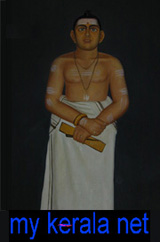Click to Enlarge !
GLOSSARY |
|
| Namboodiri | name of the brahmin caste in Kerala |
| Brahmin | the caste of the priest; the highest caste in the Hindu society |
| Malayalam | language of Kerala |
| pooram | the meeting point of all the arts |
| nettipattam | frontlet of the elephant = a large piece of cloth with thousands of gold plates stitched together sp closely making it appeal as if they are part of the elephant’s forehead |
| thidambu | replica of the idol |
| venchamaram | yak tail fans |
| alavattom | peacock feathered circular fans |
| parasol | long stemmed shimmering and glittering ceremonial umbrellas ceremonial umbrellas made out of silk and satin laced with white metal |
| kudamattam | exchange at incredible speed of parasols, thread by Brahmin priests in ‘dhoties’, flanked by two others standing with the venchamaram and alavattomaloft the backs of the tuskers |
| koodikazhcha | face-to-face procession (the 'kudamattam' along with the 'koodikazcha' are also known as the divine bazaar |
| vedikkettu | fireworks |
| melam | combined drumming |
| pandi melam | an orchestra of four instruments – the Chenda, the Kuzhal, the Kombu and the Ilathalam, played mainly in the major temple festivals of Kerala like the Thrissur Pooram. |
| chenda melam | percussion event, featuring the Chenda |
| panchavadyam | a percussion ensemble , typical of Kerala, consisting of ‘pancha’ (five) (pancha) ‘vadyam’ (instruments): ‘maddalam’, ‘edakka’, ‘thimila’, ‘ilathalam’ and ‘kombu’. |
| chenda | a double-headed drum made of soft wood with
both ends covered with cowhide. The musical notes of this instrument are
adjusted by strings and small bamboo rings. The Chenda is played either
with one hand and a stick or with two sticks beating the upper end while
being kept in a vertical position by a strap over the player's left shoulder.
Deft use of the palms can produce four different tones. It is the chief accompaniment in Kathakali (the classical dance-drama of Kerala) and the most important percussion instrument played during temple festivals. |
| edakka | an extremely sensitive percussion instrument. Made of wood and about a quarter meter long, the drumheads are held in position by interlacing cotton threads. The player beats the drum with one hand while simultaneously manipulating the strings with the other, thus creating a variety of musical notes. |
| ilathalam | a native version of the cymbals |
| kombu | a horn (kombu). It is a C-shaped wind instrument made of brass or copper. Its shrill blare helps in subduing the pitch of the other instruments |
| maddalam | known since the 13th century - is considered to be a ‘deva’ (divine) ‘vadya’ (instrument), included as a major accompaniment in the 'Dance of Lord Siva, the Destroyer'. There are two varieties: Suddha maddalam and Toppi maddalam. The former is tied around the waist of the player with a cloth, while the latter is a smaller version suspended from the neck of the player. Barrel shaped and carved from jack wood, both ends of the maddalam are covered with stretched hide and fastened by leather straps. It is also an important instrument in art forms like the Kathakali, Krishnanattom and Tullal |
| thimila | an hour-glass shaped drum made from polished jackwood. The drumheads made of calf hide are held together by leather braces which are also twined round the waist of the drum. This mechanism helps in adjusting the tension and controlling the sound. It is a must during temple rituals like Seeveli, a ceremonial procession of deities. |
| devi | goddess |
| sastha | divine combination of Shiva and Vishnu |
| paradevatha | family |
| thattakam | people of the localities where the temples are located |






